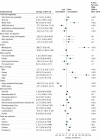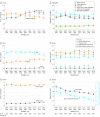Trends in Diet Quality Among Youth in the United States, 1999-2016
- PMID: 32207798
- PMCID: PMC7093765
- DOI: 10.1001/jama.2020.0878
Trends in Diet Quality Among Youth in the United States, 1999-2016
Abstract
Importance: Prior studies of dietary trends among US youth have evaluated major macronutrients or only a few foods or have used older data.
Objective: To characterize trends in diet quality among US youth.
Design, setting, and participants: Serial cross-sectional investigation using 24-hour dietary recalls from youth aged 2 to 19 years from 9 National Health and Nutrition Examination Survey (NHANES) cycles (1999-2016).
Exposures: Calendar year and population sociodemographic characteristics.
Main outcomes and measures: The primary outcomes were the survey-weighted, energy-adjusted mean consumption of dietary components and proportion meeting targets of the American Heart Association (AHA) 2020 continuous diet score (range, 0-50; based on total fruits and vegetables, whole grains, fish and shellfish, sugar-sweetened beverages, and sodium). Additional outcomes were the AHA secondary score (range, 0-80; adding nuts, seeds, and legumes; processed meat; and saturated fat) and Healthy Eating Index (HEI) 2015 score (range, 0-100). Poor diet was defined as less than 40% adherence (scores, <20 for primary and <32 for secondary AHA scores); intermediate as 40% to 79.9% adherence (scores, 20-39.9 and 32-63.9, respectively); and ideal, as at least 80% adherence (scores, ≥40 and ≥64, respectively). Higher diet scores indicate better diet quality; a minimal clinically important difference has not been quantified.
Results: Of 31 420 youth aged 2 to 19 years included, the mean age was 10.6 years; 49.1% were female. From 1999 to 2016, the estimated AHA primary diet score significantly increased from 14.8 (95% CI, 14.1-15.4) to 18.8 (95% CI, 18.1-19.6) (27.0% improvement), the estimated AHA secondary diet score from 29.2 (95% CI, 28.1-30.4) to 33.0 (95% CI, 32.0-33.9) (13.0% improvement), and the estimated HEI-2015 score from 44.6 (95% CI, 43.5-45.8) to 49.6 (95% CI, 48.5-50.8) (11.2% improvement) (P < .001 for trend for each). Based on the AHA primary diet score, the estimated proportion of youth with poor diets significantly declined from 76.8% (95% CI, 72.9%-80.2%) to 56.1% (95% CI, 51.4%-60.7%) and with intermediate diets significantly increased from 23.2% (95% CI, 19.8%-26.9%) to 43.7% (95% CI, 39.1%-48.3%) (P < .001 for trend for each). The estimated proportion meeting ideal quality significantly increased but remained low, from 0.07% (95% CI, 0.01%-0.49%) to 0.25% (95% CI, 0.10%-0.62%) (P = .03 for trend). Persistent dietary variations were identified across multiple sociodemographic groups. The estimated proportion of youth with a poor diet in 2015-2016 was 39.8% (95% CI, 35.1%-44.5%) for ages 2 to 5 years (unweighted n = 666), 52.5% (95% CI, 46.4%-58.5%) for ages 6 to 11 years (unweighted n = 1040), and 66.6% (95% CI, 61.4%-71.4%) for ages 12 to 19 years (unweighted n = 1195), with persistent differences across levels of parental education, household income, and household food security status.
Conclusions and relevance: Based on serial NHANES surveys from 1999 to 2016, the estimated overall diet quality of US youth showed modest improvement, but more than half of youth still had poor-quality diets.
Conflict of interest statement
Figures



References
-
- Healthy, Hunger-Free Kids Act, Pub L No. 111-296 (2010).
-
- US Department of Agriculture Food and Nutrition Service Healthy Hunger-Free Kids Act. Accessed September 26, 2019. https://www.fns.usda.gov/school-meals/healthy-hunger-free-kids-act
-
- US Department of Agriculture Gus Schumacher Nutrition Incentive Program (formerly FINI). Accessed September 28, 2019. https://nifa.usda.gov/program/gus-schumacher-nutrition-incentive-grant-p...
Publication types
MeSH terms
Grants and funding
LinkOut - more resources
Full Text Sources
Other Literature Sources
Medical

